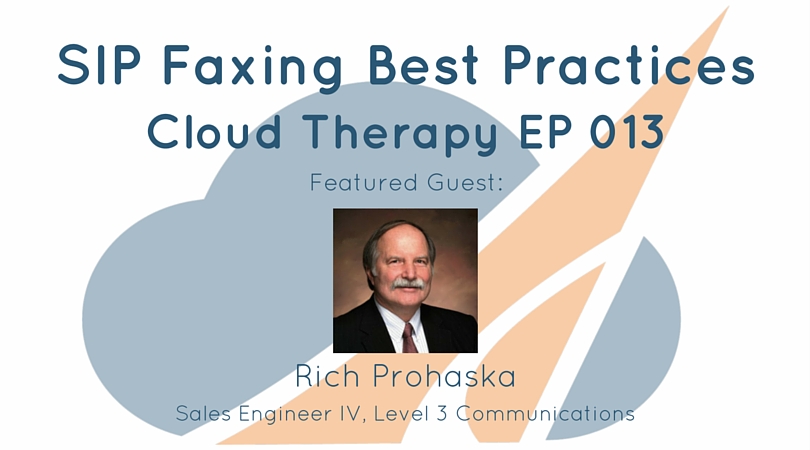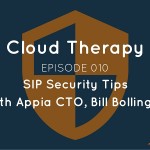So your company is moving to SIP… but what about your fax machines? Long-time Level 3 sales engineer, Rich Prohaska, joins Mike to give us some great “best practices” for faxing (well) over SIP.
Want more Cloud Therapy? Subscribe to us on iTunes or Stitcher!
Which business SIP providers have the best reviews?
Which 3 SIP providers does AeroCom recommend for your company’s size, location, and requirements? Click below.
Find the full transcript below:
Cloud Therapy Episode 13 Mike: Are you looking to move over to SIP or VoIP in any way, but you don’t know what to do with your fax machines? Well, this is a great show for you. You better know what you’re going to do with your fax machines because this is a quick way to get yourself in a bunch of mud when switching over to VoIP. I don’t know how many times I’ve heard about customers who switched over to VoIP only to find out that their fax machines weren’t working. They had ported them over to their VoIP provider and they had to undo the port, which takes about thirty days and their fax machines didn’t work for that long. You don’t want that to happen to you. If you want some tips on how to do it, today’s show is going to really help you. Today, I’ve got a great guest. His name is Rich Prohaska. He’s a Sales Engineer for Level 3. He’s been in telecommunications a long time and he really understands faxing over SIP. Today, Rich is going to go over some of the finer points to make sure that if you’re switching over to SIP, you make sure that your fax machines are going to work properly. Now, before I get to the interview, I’ve got a free giveaway for you. For those of you who are not familiar with phone service technologies, I went ahead and created a nice, little guide that lists the main types of access technologies for voice – that’s PRI, SIP, analog lines. It breaks down each of those technologies side-by-side so you can see what the differences are, how each one of them have different functionalities and features, and which technology is best for different types of business applications. I broke that down for you. It took a few hours to do, but I know a lot of you IT professionals are not that familiar with voice, so I thought it would be useful to you and I wanted to give you a free gift as a thank you for being a listener to our podcast. All you have to do to get the free gift is text the word “VOICEGUIDE” to the number 44-222. Again, text the word “VOICEGUIDE” to the number 44-222 and we will email you a free soft copy of that little chart that I did for you.
Alright. Well, thanks for joining us, Rich.
Rich: Yeah, you bet. Happy to be here, Mike.
Mike: Tell us a little bit about yourself both personally and professionally.
Rich: Well, I guess, Mike, the best word to describe it is I’ve been doing this a long time. I’ve done time in the industry. Looking back, I think, now, I’m just passing my forty year mark, which, kind of, dates me a little bit.
Mike: Wow. That’s great.
Rich: But, I’ve seen a lot of things happen in that time. When I first started, for instance, Ethernet had just barely standardized in its old stages and Bell System system had only just begun to be broken up. So, we’ve seen a lot of changes and migrations to that. I’ve been with Level 3 now about eleven of those years, so a quarter of my history has been with Level 3 as a career.
But, I’ve, kind of, done it from the ground up. I think when we’re young we all start where we can start. I grew up with the technologies. I’ve done IT for a number of years and desktop support and I really understand the pains that an IT person goes through because of the constant changing world for them. That’s been, kind of, like, the career path all along. I’ve been on the receiving end and now I’m on the delivering end of services, so I think that helps give a good overview of how best to help people.
Mike: Yeah, absolutely. I bet you that really helps people out because, you know, from the day to day… Our listeners may not know, but I know Rich is on customer appointments all the time and on the phone with clients, and talking to people just like our listeners (sys admins and IT departments from small/mid-sized companies).I bet you that gives you a lot of great perspective of what their job is like and what they’re really looking for from the service provider.
Rich: It really does. IT people enjoy technology, but many times they’re pressed into making changes that they haven’t been trained on and they’re going to be trained on – it’s all new for them. So, they really do look for somebody to advocate for them, which is a tremendous role to play as sales folks. If you can provide them answers or bring them resources… It’s not about knowing all the answers yourself, is it? It’s about knowing where to bring the information from so that the customer has that confidence in you.
Mike: Yup. That’s the whole point of our podcast because heaven knows, I don’t have all the answers. I bring the smart people on – the engineers.
Rich: Well, we don’t know all the answers, but at least we know the questions are out there and we try to help. It’s definitely been a good run. I think the longer you’re in, the more you see that people really need a helping hand. When you’re offering that help to people, it’s a real relationship builder.
Mike: Yeah, fantastic. What about your personal life? Give us a quick glimpse. You don’t have to give us your social security number or anything, but tell us about yourself personally.
Rich: Yeah, no problem. Well, I’m celebrating my fortieth wedding anniversary this summer.
Mike: Congrats.
Rich: Thank you. I know, that’s milestone. Before when I used to say thirty or thirty-five, it didn’t seem so long, but when you start saying forty, that’s a pretty big number. So, we’ve just enjoyed that. We’ve raised three sons here in Southern California and they’re married now – I’ve got grandkids on the way, so we’re enjoying that phase of life.
Then, of course, I still have the technology hobbies. Oddly enough, one of my avocations or hobbies, when I go home, is I do research on antique and historical communications equipment. So, I’m an old phone collector. It just, kind of, moves from the modern to the old and back to the modern again.
Mike: Very cool. What are one of the coolest pieces of equipment that you own? Do we, kind of, have some clue what it is?
Rich: Well, I don’t know if you would. I specialize in military communications. Now, that sounds sophisticated, but it’s not sophisticated if you’re talking about the trench warfare in World War I. I have some old, portable telephones that were in oak boxes that weigh about 25lbs. Our great, great grandfathers strapped those over their shoulders and carried those into battles. I didn’t envy them. That box was a pretty heavy telephone.
Mike: That is really cool. You know what? What I’ve noticed is a lot of IT professionals got their start in the military, so I know that a lot of our listeners are hearing that thinking that is really cool because they’re probably into something very similar – that, kind of, hits home for them too. I think that’s really neat, especially just the history of World War I and communications – where it used to be and where it is today. That’s really neat. Cool.
Rich: Yeah, it is. It’s a long timeline and I enjoy it and, you know, reading about it. It’s just not owning a phone, but researching, and there are a lot of biographies and stories online that you can read about – the situations that people were in and how they were used. I find it fascinating.
Mike: Any fun stories about where you found something or any neat stories about how you came across any of your collections, the pieces in your collections, like at a garage sale or something or somebody didn’t know what they were even holding?
Rich: Well, I suppose that’s the most fun. It’s when somebody doesn’t know what they’re holding. At some point that diminishes because I’m all excited and they’re not, and they don’t understand why I am. But, yeah, I mean some things are, you know, they are broken up into pieces and you just find a component and it doesn’t look like anything to somebody but you know what it goes to, so it is fascinating.
I have walked into many antique stores that sell teacups and doilies, and in the back shelf in the bottom is an old wooden box, and I open it up and there it is. I’ve had one of those experiences and that was, kind of fun to have, then, to be able to tell them what that was.
Mike: Wow, that’s really cool. That’s neat. In our last office we had pictures up on the wall of the history of communications technology, so we have all these different pictures like the person that they call the godfather of broadband. Obviously, Alexander Bell and, you know, the history of email, like, how that started, so I think all that stuff is really fascinating. I think anybody around IT, or telecommunications, or Datacom cloud services like me started looking into that stuff. It’s really cool of where it started and how it became what it is today.
Rich: I think it is. Sometimes, it helps, either, from an anecdotal story part, to be able to relate to people where things came from and also very practically. Sometimes, there is some real understanding as to why things are the way they are today. Why we do 23 + 1 on a PRI – there’s a history behind it. Why we do the bit robbing and the bit stuffing on T1 circuits – that was all very historical stuff. So, it’s been fun to know where it came from, but I do enjoy the new stuff as well to see, wow, we have erased all those barriers that we used to have and now we’re doing things we’ve never dreamed of. Companies are definitely leveraging that to help their bottom line.
Mike: You just gave me a great idea for a bonus episode after launch, like, mid-week or something. We’ll interview you and have you tell us some of those stories. I think that would be awesome just to hear some of the stories behind why we use 23 + 1 or something. I think that’s great.
Rich: You know, I’ve got a little story I tell. I get teased about it, but it’s “Where did the T1 come from?” because we’re still using them today. It’s actually a long and colorful story, so maybe we’ll do something like that. You’re right, we’ll have to schedule that.
Mike: I love that teaser. So, you guys better keep listening because we’re going to release that one of these days, where the T1 comes from, so you better keep checking our episodes on iTunes.
Rich: I agree.
Mike: Alright. Well, good. Let’s jump into the topic now.
Rich: Alright, let’s go.
Mike: Awesome. Well, today, Rich is going to talk to us today about SIP and faxing especially when it comes to two different scenarios.
Say, your company is looking to move to SIP, maybe, from PRI or analog lines and you have fax machines. What things should you be thinking about when it comes to SIP and fax machines?
The second scenario he’s going to talk to us today about is SIP and fax servers.
Let’s start with fax machines, Rich. Say, a company is looking to convert over to SIP and their IT department knows that they have fax machines, what are some of the things they should be asking themselves?
Rich: Well, those kinds of fax machines, Mike, are pretty common as we all know. Most offices have at least one basic fax machine and it’s connected to a POTS line, old analogue-style phone line like we have in our homes. Those services are oftentimes either on a direct line that they’ve gotten from the ILEC or sometimes it’s a line that’s connected to their existing PBX off of a line card. It’s sometimes overlooked to really ask about that because it’s assumed that it will continue to work as it always has.
Mike: Right.
Rich: That assumption, you know, is really where we all get in trouble. I would consider asking about any kind of faxing in my top five questions when I’m out there visiting a customer and trying to figure it out because that’s a real issue.
The first solution, and it’s often the most obvious, is to leave the fax machines alone if they are on standalone lines that they have purchased directly from the ILEC. That’s often the best way to do it especially when you’re going to be so busy converting everything else to SIP. The last thing that the IT team needs to be dealing with is how to get their fax machine working again. You could approach it as a phase approach even – say we’ll deal with those fax machines later.
Now, sometimes you’re not afforded that luxury because you find out that the fax machines are actually running off of a line card that creates the line off of the PBX. So, then, you have to face it.
You have to deal with it now. An answer to that question could be: Does your new SIP PBX enable that functionality? Does it create analog POTS lines to keep those fax machines working? If the answer is “no,” then they may really want to take a step back and order a POTS line or two from the ILEC to cover that conversion and take care of that up front. That’s definitely one solution.
Mike: Okay. So, then, they’d ask: Does your PBX create analog fax lines when you’re connecting faxes to the phone system?
Rich: Right. That’s what you really want to drill down. Are your fax machines directly connected to your phone system today or phone line rather than just a wire that runs over to the local telephone company? If it’s running to the local telephone company, it can stay there. If it’s running through the PBX, then they want to ask a little bit more. How is that going to be handled on the new phone system?
Mike: Okay. What are some of the things they should be leery of when they go ask the new phone system vendor how the faxes are going to be handled through your phone system? What are some of the things they should be listening for?
Rich: There are two standards that we’re going to be talking about. I’ll bring it up all throughout the call. SIP faxing uses a standard T.38. That’s the conversion of faxes to SIP. They want to find out if that has been addressed locally. It’s actually not a carrier or a provider question. It’s more of a vendor PBX to customer question. A good PBX vendor would have covered that. What am I connecting to this? If they’re running around putting in new handsets on all the desks, they probably asked, “Do you have fax machines that need to be connected as well?” So, that’s the first thing I’d ask.
Mike: Okay. Got it. And then, you mentioned T.38. Is that pretty much the way most phone systems are going to be transmitting the faxes. Is it through T.38? Where does that come up in a conversation with you and your phone system vendor?
Rich: No, it’s good. The default and the legacy standard is T.30. That is what we call a “pass-through.” It is an old function that’s been around for a very long time. Even new PBXs can be set to default and run through T.30 standards. Again, it’s a vendor support issue. It would give you a lot of confidence if your vendor actually can talk about that quite fluently. That’s a good sign that you’ve got a good vendor that you’re working with.
The SIP PBXs also support, usually, the newer T.38 standard, so we have to define that up front as to which one they’re going to actually implement. If they implement T.30, traditional, legacy, pass-through faxing, you’re probably going to be able to stop right there and that’s going to be enough. If the vendor wants to implement T.38, then you have to ask the provider “Does your SIP service support T.38 faxing?” Level 3 does, but not all do. It’s a good question to ask and uncover that before we get too far into the process.
Mike: That’s interesting. I was not aware of that. So, some SIP providers only support the old standard T.30 and they don’t support the newer standard T.38?
Rich: Yeah, that’s correct. It’s even more complicated than that. T.38 is still relatively new by comparison to the legacy fax standards of T.30. Because it’s new, it means that different manufacturers of fax equipment support it slightly differently. They may all support the core T.38, but there are optional variations on feature sets that they enable or they don’t enable so that you don’t always even have compatibility end to end. We, certainly, all may be able to carry the signal, but the end device may not support all of the features and options, so you can run into trouble with T.38. I think that’s why we find PBX vendors supporting both.
Mike: Okay. That makes sense. So, say, somebody checks with their SIP service provider and they do support T.38, is there anything beyond that that they should be checking internally to make sure that they’re not going to have a problem with faxing over SIP?
Rich: Well, once they verify that the vendors do support T.38, there’s, kind of, a practical tip that a customer could be made aware of. Most faxing errors over SIP occur when they have very large documents to fax. When they have a multi-page ten/fifteen pages or more, you end up with a very large fax file that has to be transmitted. One way to mitigate issues that could occur is to get the customer, if possible, to break the documents up into smaller pieces. They don’t have to send all thirty pages at one fell swoop. They can do five here, seven there, and run something like that. That will minimize the size of the file and help guarantee successful transfer.
Another option would be actually going over to the physical fax machine, which they’re probably not replacing. They want to reuse that same fax machine with the new PBX. So, have the customers slow the speed of the fax machine down – most of the newer fax machines are running quite quickly, you know? They’re running up 56 kbps. They want to slow those down to the older, like, 9600 speeds to minimize errors.
Remember, the faster you go, faster is usually accomplished by compression. If you have one small error with compression, then you usually get a failure because it damages quite a bit of the file because it’s compressed. If you slow it down, you minimize compression or it’ll be turned off altogether, and that will help ensure that the fax will go through.
Mike: Got it. I think that’s a great tip. I definitely just learned a couple of things. You might have missed one thing. The IT department – what about walking over to those users and asking them,
“Why the heck are you faxing? Can you please scan that and email it?” I’m kidding.
I know that there are some industries that still have to use faxes for whatever reason. One of them, I know, is the state. I’m always having to fax the state stuff for our corporation. I’m like, “This is ridiculous. Don’t they have an email address so I can scan something and send it to?” But, yeah, for whatever reason, some people still have to use fax. That’s got to be frustrating for them if you’re still having to fax thirty-page documents these days.
Rich: Yeah, it really is. It, kind of, steps into the, probably, the next area is where people have larger faxes, maybe even, like, a fax server. I’m sure you’ve heard of people running into those all the time.
Mike: Yes. Tell us about that. If you’re running a fax server and you’re looking to convert over to SIP, what are some of the questions you need to be asking?
Rich: Well, a fax server takes you to the whole next server, doesn’t it? It’s really a bigger application and it tells you, right off the bat, that this company is serious about faxing. I think you need to sit up in your chair and take some good notes, and then bring in a good vendor to help you with that. The reason being is, the fax server is going to be a whole separate machine and it’s going to have a special communication card that’s been installed in that machine.
If it’s a very old fax machine… So, you do want to find out about how long they’ve had it, how old is it. Some of the very oldest fax machines use very old signaling format where they have direct, inward dial trunk groups. They’re not PRIs, they’re not voice T1s, they’re six/seven lines that are grouped together in a special digital trunk format. You want to identify that. That definitely needs to be replaced and, really, isn’t supported by anything that’s been made in the last eight to nine years. But, anybody that uses it a lot, most likely, will be somebody who is using a PRI connected to that fax machine.
Mike: Okay.
Rich: In that case, then, it really does come down to where is that fax machine going to get the PRI from? Again, your phone vendor comes into play. We often think a PRI is coming into a PBX, but some PBXs can also output a PRI into a fax machine. Again, you want to ask if this fax server going to be connected directly to the PBX through a PRI or, better yet, if it’s in its own PRI and if it can be left alone. I know it sounds, kind of, cowardly, doesn’t it, Mike, to just leave where it is for now? But, you can save yourself a lot of grief.
If a customer is spending his effort converting his desktop handsets and his PBX, he’s got a lot of migration going on to begin with and a lot of retraining. You can view it as a strategy to spread the changes out over time and pick up that fax server in a phase two mode and say, “Let’s leave it on that PRI today. Let’s not have that be part of phase one and we’ll come back and visit that later on.”
Mike: I think that’s a good way to do it. That may not make your sales rep that happy because they want to grab everything right away in one fell swoop, but, obviously, they’re not concerned about the installation problems that you might have – they’re worried about that commission checks. I think that’s a good way to approach it.
Now, what if they’ve done that and now comes the time for them to actually want look into it? Say, they’ve had SIP up and running for six months or so, or a year, and they go, “Hey, I wonder if we can move that fax server off this PRI and stop paying for the PRI circuit, and move this over to SIP as well for the cost savings?” What are some of the questions they should be asking themselves and what are some of the possible fixes to those glitches they might encounter?
Rich: Okay. Now, that is where the next question goes, isn’t it? The fax server that’s going to use SIP, and that’s what the customer really wants to do, they’re going to be connecting it with an Ethernet card into the network. That fax server, really, just becomes almost like another handset on the network. It’s going to communicate directly to the PBX and then, in turn, leverage the SIP trunk.
Some obvious notes: One of them is the fax server is probably a separate fax numbers that have to be ported over to the SIP service, so you have to account for those. Secondly, the very same questions that you ask about standalone fax machine have to be asked about the fax server. In other words, are you going to communicate to the PBX using T.38 or are you going to use T.30? So, find out about that.
Then, of course, once you find out which one they’re using… T.30 is supported by all fax services because it’s pass-through, but T.38, again, you’ll have to ask your carrier that’s providing your SIP,
“Do you support T.38 faxing over your SIP trunk?” Level 3 does, but not all providers do, so that’s a great question because if you don’t ask it, you’ll be embarrassed later on.
Mike: Right, that makes sense. So, say, they got that ironed out, is there anything else that they should be thinking about?
Rich: Well, there are some options. Some companies will continue to offer, say, PRI support that can be converged or blended with the SIP offering. That doesn’t necessarily help with the fact that there’s still a separate circuit for PRI, but it might ease the migration paths, so, again, you have to, kind of strategize and decide how many projects you want to tackle at once. Like Level 3, we offer both SIP and PRI under Voice Complete. They blend together and they call paths, they can share the billing model there on the same bill, and so on and so forth.
If they don’t have that, then, just by identifying, again, T.38 faxing and how they want to do it is the big play there. Quite frankly, your level of confidence as a sales person will be greatly bolstered by the vendor, by the PBX vendor, not really by the carrier, because the connection’s going to go between the PBX and the fax server, not between the carrier and the fax server. That’s where you really need to gain your confidence in the vendor that they’re really doing their job.
Mike: That makes sense. Now from a customer standpoint, if they went with a provider that can give them a PRI handoff from a SIP connection… I know, sometimes, there are possibilities like, for instance, say, they’re going from a full PRI plugged into that fax server, would there be an opportunity for them to get a cost savings to only light up a few PRI trunks, if they did it that way, as opposed to needing a full PRI if they’re using a SIP-PRI combination there?
Rich: Yeah, that’s a fair question. A lot of fax servers might be over trunked. They may have lit it up with a full PRI and, really, only need a dozen channels or half a dozen call paths to come down into the fax server itself. That could be a cost savings by asking for fewer call paths to be provider.
That’s where you get into this interesting game of if it’s on a separate circuit from the provider, a separate T1 circuit, you often have to pay for the full circuit, but then you can reduce the number of call paths. That’s a great way to save some money there if you have to maintain it separately.
Mike: Right. That makes sense. Well, great, I think those are some good tips. Those are some good takeaways for everybody who’s looking to move over to SIP.
Obviously, every business almost still has fax machines around. If you don’t address that, you’re really leaving yourself for some big technical glitches. All of sudden that one person who uses the fax all the time (you didn’t think anybody used it) is complaining that the faxes don’t work and, now, you’re, kind of, working backwards through that install and trying to redo things, which always takes a lot more time, in my experience, than if you just addressed it up front.
Carriers move real slow when it comes to porting numbers over back to an analog line. You’re looking at two to three weeks minimum, probably, to get that problem resolved and get that number back over to your analog line if you’re having an issue. So, I think those are some great tips for people to look at upfront and hopefully avoid some of those. I appreciate you sharing them with us today.
Rich: Yeah, glad to. It’s unfortunate, but faxing is the tail that wags the dog. You can have a wonderful conversion to SIP, great handsets, training, excellent vendor support, but if their faxes quit working, that tail is going to wag you crazy as you’re trying to fix it.
Of course, Mike, you know what the ultimate fix is? Get the faxing off-premise, get it up in the cloud, and go for a fax service company that does it up in the cloud for them. They probably were thinking about it anyway. It’s one less headache. I suppose that’s the ultimate solution, but the suggestions we made were for those companies who are going to retain it and then you need to be aware of it.
Mike: Awesome. Great. Thanks. Well, let’s shift gears now to something a little bit more fun. As we always liked to ask, tell us about something that’s, kind of, fun, interesting, or one of the coolest things you’ve ever witnessed in the workplace.
Rich: Well, I don’t know about cool, but workplaces can be funny. I don’t know about your place, Mike…
Mike: I’ve seen a couple of interesting things over the years where I’m like, “Man…” especially when I was working for a big company. When I was working for XO, we had about a hundred people in the office that I was in. When you get a hundred people, which, probably, twenty or thirty of them were sales people, you get some interesting stories, there are some characters.
Rich: Well, it is funny. I mean, you know, the standing joke is all about we’re a technology company, but we, sometimes, can’t use technology ourselves. I suppose my story will run along the lines of that.
We had a sales person who is trying to print out a presentation to take on a customer meeting. They had asked their engineer to make a network design Visio drawing that they can print out and bring with them. As we all know, a picture’s worth a thousand words, so it sounds like a great idea, doesn’t it, Mike?
Mike: Yeah.
Rich: But, it turned out that the engineer had drawn the diagram and formatted it not only in landscape but on 11 x 14 paper. That was not caught by the sales person when they were trying to print it out on 8.5 x 11 paper. I think they spent an hour at the copy machine fixing jams because they were trying to force a small piece of paper in when it really needed five or six more inches of paper to print on. They used some interesting vocabulary and none of it was technical, I can assure you.
Mike: I know one thing all of our listeners are probably asking since they’re the IT department: Did the person call the IT department? Because I’m sure they’ve gotten a ton of calls with people having the same problem or did they just try to resolve it on their own?
Rich: Well, it took another sales person to come along who’ve had a similar problem. They didn’t call IT. They just kept hitting the buttons harder and yelling at the machine as if it accepted verbal commands. That didn’t work.
The point was that the copy printing machine, which can do so many things, has a very complicated display. In the end, it was giving a message saying that the wrong-sized paper had been selected. Had they just followed the menu instructions on that little square window, they would have been fine. It took another person with experience to come along and rescue them. Otherwise, I don’t know if they’d still be there trying to get the paper out.
Mike: That reminds me so much of all the threads I’ve seen on the IT forums out there like Spiceworks and stuff. They’ll say, like, users are saying the printer’s not working and the first thing they’ll ask them was “What was it saying?” Then, they walk over and it says “Paper Jam. Tray 2,” or something, and they’re like, “Oh, I don’t know. It just wasn’t working.” Sometimes, the answer’s right there – just read the instructions – but I don’t know. I shouldn’t make fun of them because some people – that’s just not their thing. They’re really good at other stuff, I guess, but that’s a funny story nonetheless.
Yeah, okay. Tell us a little bit about Level 3 now. Obviously, I think everybody listening has probably heard of Level 3. If you haven’t, just Google it, you’ll know a lot about them. It’s one of the largest ISPs in the world. Tell us a little bit about Level 3. What’s going on over there that’s exciting these days, that you’re excited about?
Rich: Well, why don’t we just stay on the voice theme? There’s been, I think, three big announcements that we’ve done internally. One of them has to do with our extended security offerings that we’re offering where we’re installing these cloud-based firewalls and offering a tremendous flexibility in how people can connect remotely into their networks. That’s a big one. It definitely emphasizes hybrid networking, which maybe we could even talk about at a separate time because it involves a lot of technology.
On the voice announcement side, as we were talking about SIP, one of the most recent things that we’ve announced is voice in Europe using Voice Complete. We’re now offering SIP out there and that’s amazing because, in the past, we’ve had voice in Europe, but it was somewhat of a legacy product that had limitations to it. The new Voice Complete product orders up just exactly like you can order a SIP trunk here in North America.
The whole globalization strategy where companies are locating all over the world, it’s great to be able to get one invoice, and share one structure, and one technology. So, that’s a big one for us.
Mike: Very cool. Thanks for sharing. That’s great. So, yeah, if anybody out there is looking to add some voice to those international locations in Europe, give us a call over at Aerocom. We’ll get you in touch with Rich, and we’ll, kind of, walk through that as far as your possibilities might be.
Rich: Glad to. Happy to talk to anybody about that.
Mike: Great. Alright, Rich, thanks for joining us on the show today. That was some good info and I appreciate you taking the time.
Rich: alright. Glad to be here. Thanks for asking me, Mike. Have a great day.
Mike: Well, I hope that taught you a little bit about faxing over SIP. I know I definitely learned a lot from it. We can guarantee you, Rich will be back to talk about the history of T1s and all that good stuff. I love hearing about that kind of stuff and I know a lot of our listeners do too.
Before I go, don’t forget to pick up your free gift. I spent hours doing it, so make sure you collect it. it’s a voice guide that breaks down the different major voice technologies that businesses can use and let you know which features and functionality each have that are different when it comes to PRI, SIP, and analog lines. Just text the word “VOICEGUIDE” to the number 44-222. Again, text the word “VOICEGUIDE” to 44-222 and we’ll email you a free copy of that little cheat sheet.
Alright, talk to you next time. Have a great day.







